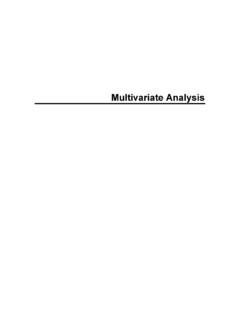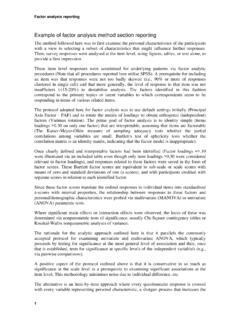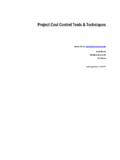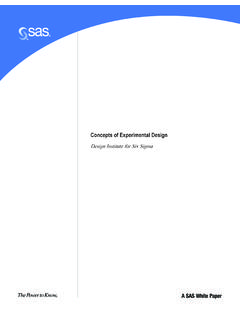Transcription of Operation Urgent Fury: Operational Art or a …
1 AD-A284 722 Operation Urgent Fury: Operational Art or a strategy ofOverwhelming combat power ?A MonographbyMajor J. Mike SimmonsAviationSD-TIC' ' SEP Z2 1994 GSchool of Advanced Military StudiesUnited States Army Command and General Staff CollegeFort Leavenworth, KansasREPORT DOCUMENTATION PA6E .J. NO 0,0,,Pt t i. 4 Sf b1.(4S1 mtOn t .t410difa 1i qd9* dn1t1 IsieI. r i ,, AGENCY USE ONLY (Leave b~lank) Z2~ 2~ 3. REW&Wkfif DATES COVERED4. TITLE AND SUBTITLE S. FUNDING NUMBERSOPERATION Urgent fury : Operational ART ORA strategy OF overwhelming combat power ? (U)6. AUTHOR(S)MAJ J. MIKE SIMMONS, USA7. PERFORMING ORGANIZATION NAME(S) AND ADORESS(ES) B. PERFORMING ORGANIZATIONREPORT NUMBERSCHOOL OF ADVANCED MILITARY STUDIESATTN: ATZL-SWVFORT LEAVENWORTH, KANSAS 66027-6900 COM (913) 684-3437 AUTOVON 552-34379. SPONSORING/MONITORING AGENCY NAME(S) AND ADDRESS(ES) 10. SPONSORING IM ONITORINGAGENCY REPORT NUMBER11. SUPPLEMENTARY NOTES12a. DISTRIBUTION / AVAILABILITY STATEMEWt 12b.)
2 DISTRIBUTION CODEAPPROVED FOR PUBLIC RELEASE; DISTRIBUTIONUNLIMITED13. ABSTRACT (Maximum 200 words)SEE ATTACHED SHEET94-3046294914. SUBJECT TERMS IS. NUMBER OF PAGESOPERATIONAL ART Operation Urgent fury 54 Operational DESIGN 16. PRICE CODE17. SECURITY CLASSIFICATION i1,. SECURITY CLASSIFICATION 19. SECURITY CLASSIFICATION 20. LIMITATION OF ABSTRACITWO MSSIFIEDI ObItJiAIFIED OWM 9 SIFIED UNLIMITEDNSN 7540-01-280-5500 Standard form 298 (Rev 2-89)PIrurbd by ANV Sid 139I SSCHOOL OF ADVANCED MILITARY STUDIESMONOGRAPH APPROVALM alor James M. SimmonsTitle of Monograph: Operation Urgent FuKy: Operational Art ora Stratery of overwhelming ' combat power ?Approved by:LTC Michael C. Burke, MMAS Monograph Director1VI .Deputy Director,Robert H. Berlin, School of AdvancedMilitary Studies__ __ _. __ __ __ __ _Director, GraduatePhilip J. Brookes, Degree Program*D7 LTC q'0 ALZ77~Accepted this 6th day of May 1994 Operation Urgent fury : Operational ART OR A STRATEGYOF overwhelming combat power ?
3 By MAJ J. Mike Simmons,USA, 58 the ever increasing rise in regionalconflicts and micro wars, Operation Urgent fury mayexemplify the types of short notice contingencyoperations we may be faced with in the future. Tofacilitate success in these potential conflicts,American military commanders must understand thecritical elements of Operational art and monograph examines Operational art theory anddoctrine as derived from both classical andcontemporary theorists, and compares that doctrine withthe planning and execution of Operation Urgent analysis of the theoretical and doctrinal constructsrevealed three common elements conducive to theapplication of Operational art. First, the strategicand subsequent Operational objectives must be clearlyarticulated and understood. Second, the campaign ormajor Operation must be properly sequenced andsufficiently resourced to attain the objectives. Last,the six Operational functions of command and control,intelligence, movement and maneuver, fires, support,and protection should be integrated into the planningand execution monograph concludes that the planning andexecution of Operation Urgent fury was not operationalart.
4 While some of the theoretical and doctrinalcriteria were present, there was a generalmisapplication of the six Operational functions whenmatched with the commander's vision. Operation UrgentFury was successful, however, due to the overwhelmingapplication of superior combat power against a secondrate opponent. Though this approach proved suitable ina single contingency such as Grenada, future multiplecontingency operations which neglect the salientfeatures of Operational art in their planning andexecution could prove disastrous. Accesion For 4 NTSNTIS CRA&I IC A .Unarmoi::ctd .! lLBcy ____ ..iiicD iibltio,,/Availability Co 'esDist Special10 / IITABLE OF CONTENTST itle Page .. iApproval Sheet .. iiAbstract .. iiiTable of Contents .. ivI. Introduction ..1II. Theory and Doctrine of Operational Art .. 3I11. Operation Urgent fury .. 22IV. Comparison of Doctrine and Application .. 29V. Conclusions .. 40 Endnotes .. 43 Bibliography .. 54ivI. INTRODUCTIONThe recent demise of the Soviet Union and thesubsequent global shuffle in the balance of power haveresulted in a dramatic shift in the US nationalmilitary strategy .
5 The significant forward presence ofUS forces on foreign soil which was so prevalent duringthe Cold War has been replaced by a strategyemphasizing Continental United States (CONUS) basedpower projection capability.' With ever increasingincidents of regional conflicts and micro wars, the USinvasion of the island of Grenada in 1983, OperationUrgent fury , may typify the short notice contingencyoperations facing the US in the not too distant Urgent fury was the first major,conventional military Operation that the USparticipated in following the Vietnam War. It wasplanned and executed at a time when US military forces,particularly the Army and Air Force, were refiningprocedures derived from the newly published AirLandBattle doctrine contained in the 1982 This doctrine emphasized a more fluidapplication of combat power . As such, it sharpened theappreciation of Operational depth and maneuver throughstronger service integration and emphasized thecriticality of the Operational level of war.
6 However,the subsequent edition (published in 1986) was the1first to mention Operational art in military officers proclaimed OperationUrgent fury as a flawless triumph of the Americanmilitary. Admiral Metcalf, the commander of theoperation, stated that the American forces "blew themaway."3 But the Operation was not without its shareof disappointments and shortcomings. Numerous post-invasion analysts have cited overwhelming combat power ,the combining of sufficient force to ensure successwhile simultaneously denying the enemy the chance toescape or retaliate, as the compensating factor forincompetence and poor intelligence.' These criticsargue that a complete superiority of means was theprimary reason for the US victory,s relegating anyoperational design considerations as unimportant ornon-existent at the time. Was overwhelming combatpower the keystone to the triumph on the island ofGrenada in 1983, or did the military planners applyoperational art in the design and execution ofOperation Urgent fury , thus ultimately ensuring thevictory?
7 Through an analysis of the theoretical anddoctrinal underpinnings of Operational art, theplanning and execution of Operation Urgent fury , and acomparison between the doctrinal constructs and theactual Operation , this monograph answers that , using Operation Urgent fury as thebaseline, the findings of this study may serve asuseful components to consider when designing andexecuting a potential campaign plan for future short-notice, power projection contingency THEORY AND DOCTRINE OF Operational ARTTo lay the foundation for the subsequent analysisof Operation Urgent fury , a theoretical and doctrinalframework is necessary. This framework provides thefoundation and evaluation criteria needed to determinewhether Urgent fury was indeed Operational art or justthe application of overwhelming combat , in its broadest sense, is a way to explaina set of facts or circumstances. It is generallydescriptive and provides the conceptual principlesnecessary to communicate a basic and commonunderstanding for a particular subject.
8 As such,theory serves as the primary frame of reference forthought and discussion on that subject and provides abaseline for further intellectual development. Soundtheory should be both explanatory and predictive,inclusive and expansible, and transcend time andcircumstances."The concept of a particular level of war occurringbetween the strategic and tactical levels, commonlyreferred to today as the Operational level, is not a3new phenomenon in the course of military the actual inception of the operationallevel of warfare as a profoundly different concept whencompared to the tactical or strategic levels is asubject open to heated debate, discussion, anddisagreement. However, prior to the recognition andarticulation of an Operational level of war, strategyand tactics were almost exclusively the mainstays ofmilitary his book Qn War, Clausewitz made a cleardistinction between strategy and tactics. He felt thatstrategy determined the reason, timing, and locationfor battles and engagements, whereas tactics concernedthe specific techniques associated with how battleswere fought and Clausewitz based his theoryprimarily on the battles of Frederick and Napoleon, atime when military operations lacked the complexity ofindustrial age warfare.
9 Careful analysis ofClausewitz, however, reveals elements of today'sconcept of the Operational level of war interspersedthroughout his book. In fact, though not defined asthe Operational level, the idea of linking operationsand engagements to attain a strategic objective are anintegral component of Clausewitz' concept ofstrategy.*Another notable theorist who contributed to the4development, understanding, and eventual recognition ofthe Operational level of war was Antoine Henri Clausewitz, Jomini never specifically articulatedan Operational level. In The Art of War, Jominidefined strategy as "the art of making war upon themap, [which] comprehends the whole theater ofoperations."' Conversely, tactics to Jomini were thedetailed techniques an army used to successfully wagebattles and conflicts. However, closely associated totoday's concept of the Operational level of war wasJomini's idea of grand tactics, "the art of forminggood combinations preliminary to battles as well asduring their "* Jomini, like Clausewitz,helped to lay the theoretical foundation for furtherdevelopment and refinement of the Operational level Russian military theorists writing at theturn of the Twentieth Century can best be credited withdeveloping the notion of the distinct attributes ofoperational warfare in general, and the key elements ofoperational art in particular.
10 These Russiantheorists, who based their assessments on thoroughstudies of the Russo-Japanese War, World War I, theRussian Civil War, and the Russo-Polish War of 1920,realized the nature of warfare had shifteddramatically. Further, they postulated that an5exclusive understanding of strategy and tactics alonewas inadequate for the prosecution of future theoretical analysis, combined with the changingnature of warfare, resulted in their recognition of anoperational linkage between tactics and strategy ."'The Operational level of war then, recognized as adistinct category and form of military theory separatefrom tactics and strategy , can trace its roots to theSoviet Union during the period between the First andSecond World Wars. Soviet theorist and General-MajorAlexander Andreevich Svechin first applied the termoperational art in his mid-1920 military writings andlectures. Svechin realized that the nature of war hadundergone profound changes which mandated anunderstanding beyond the realm of tactics and , in his 1927 book S, he used theterm Operational art to describe the gap betweentactics and strategy , defining it as the "totality ofmaneuvers and battles in a given part of a theater ofmilitary action directed toward the achievement of thecommon goal.

















